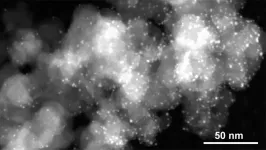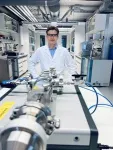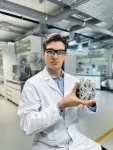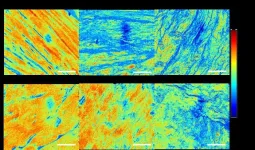(Press-News.org)
Acetaldehyde is a vital chemical used in making everything from perfumes to plastics. Today, its production largely relies on ethylene, a petrochemical. But increasing environmental concerns are pushing the chemical industry to reduce its reliance on fossil fuels, so scientists have been searching for greener ways to produce acetaldehyde.
Currently, acetaldehyde is produced through the so-called “Wacker process”, a chemical synthesis method that uses ethylene from oil and natural gas with other chemicals such as strong acids, i.e. hydrochloric acid. The Wacker process not only has a large carbon footprint but is resource-heavy and is unsustainable in the long run.
A promising solution to this problem is the electrochemical reduction of carbon dioxide (CO2) into useful products. As CO2 is a waste product that contributes to global warming, this approach tackles two environmental issues at once: it reduces CO2 emissions and creates valuable chemicals.
An innovative catalyst for greater efficiency
Copper-based catalysts have shown potential for this transformation, but so far, they’ve struggled with low selectivity — which means that they produce a mixture of products rather than the desired acetaldehyde.
Now, scientists of a public-private consortium, led by Cedric David Koolen in the group of Andreas Züttel at EPFL, Jack K. Pedersen at the University of Copenhagen, and Wen Luo at Shanghai University have developed a novel copper-based catalyst that can selectively convert CO2 into acetaldehyde with an impressive efficiency of 92%.
The breakthrough, published in Nature Synthesis, provides a greener and more sustainable way to produce acetaldehyde, and could replace the Wacker process. Moreover, the catalyst is scalable and cost-effective, opening the door for industrial applications.
“The Wacker process effectively hasn’t changed in the past 60 years. It is still based on the same basic chemistry. The time was ripe for a green breakthrough,” says Koolen.
“Fascinating chemistry”
The researchers began by synthesizing tiny clusters of copper particles, each about 1.6 nanometers in size, using a method called spark ablation. This technique involves vaporizing copper electrodes in an inert gas environment, and allowed the scientists to precisely control particle sizes. The copper clusters were then immobilized on carbon supports to create a stable and reusable catalyst.
In the lab, the team tested the catalyst’s performance by running it through a series of electrochemical reactions with CO2 in a controlled environment. Using a synchrotron — a large scale facility that generates a very bright light source — the team ensured that the copper clusters were actively converting CO2 to acetaldehyde by a technique called X-ray absorption spectroscopy.
The results were remarkable. The copper clusters achieved 92% selectivity for acetaldehyde at a relatively low voltage, which is essential for energy efficiency. In a 30-hour stress test, the catalyst demonstrated high stability, maintaining its performance across multiple cycles. The researchers also found that the copper particles retained their metallic nature throughout the reaction, which contributes to the catalyst’s longevity.
“What was really surprising to us was that the copper remained metallic, even after removal of the potential and exposure to air,” says co-lead author Wen Luo. “. “Copper usually oxidizes like crazy, especially copper that small. But in our case, an oxide shell formed around the cluster protecting the core from further oxidation. And this explains the recyclability of the material. Fascinating chemistry.”
The keys to success
Why did the new catalyst work so well? Computational simulations showed that the copper clusters feature a specific configuration of atoms that promotes CO2 molecules to bond and transform in a way that favors the production of acetaldehyde over other possible products, like ethanol or methane.
“The great thing about our process is the fact that it can be applied to any other catalysts system,” says co-lead author Jack K. Pedersen. “With our computational framework, we can quickly screen clusters for promising characteristics. If it’s for CO2 reduction, or water electrolysis, with spark ablation we can produce the new material with ease and directly test it in the lab. This is so much faster than your typical test-learn-repeat cycle.”
The new copper catalyst is a significant step toward greener industrial chemistry. If scaled up, it could replace the Wacker process, reducing the need for petrochemicals and cutting down on CO2 emissions. Since acetaldehyde is a building block for many other chemicals, this research has the potential to transform multiple industries, from pharmaceuticals to agriculture.
Other contributors
Empa Materials Science & Technology
University of Copenhagen
VSPARTICLE
Paul Scherrer Institute, Switzerland
EPFL Environmental Engineering Institute
Technical University of Delft
Shanghai University
Reference
Koolen, C. D., Pedersen, J. K., Zijlstra, B., Winzely, M., Zhang, J., Pfeiffer, T. V., Vrijburg, W., Li, M., Agarwal, A., Akbari, Z., Kuddusi, Y., Herranz, J., Safonova, O. V., Schmidt-Ott, A., Luo, W., Züttel, A. Scalable synthesis of Cu cluster catalysts via spark ablation for the highly selective electrochemical conversion of CO2 to acetaldehyde. Nature Synthesis 03 January 2025. DOI: 10.1038/s44160-024-00705-3
END
Scientists have uncovered a powerful ally in the fight against neurodegenerative diseases: a nucleolar complex that plays a pivotal role in maintaining cellular health through protein homeostasis (proteostasis), by which cells maintain the balance and proper functioning of their proteins. By suppressing this complex, researchers have shown it’s possible to dramatically reduce the toxic effects of Alzheimer’s-causing proteins, boosting the cell’s natural defenses through enhanced degradation of hazardous proteins. This mechanism regulates proteostasis across tissues by modulating TGF-β signaling, a pathway involved in cell growth, differentiation, ...
CORVALLIS, Ore. – Scientists including an Oregon State University chemistry researcher have taken a key step toward faster, more energy-efficient artificial intelligence, and data processing in general, with the discovery of luminescent nanocrystals that can be quickly toggled from light to dark and back again.
“The extraordinary switching and memory capabilities of these nanocrystals may one day become integral to optical computing – a way to rapidly process and store information using light particles, which travel faster than anything in the ...
Brazil’s Bolsa Família Program (BFP), one of the world’s largest conditional cash transfer programmes, was responsible for the reduction of more than half the number of tuberculosis cases and deaths among those living in extreme poverty and indigenous groups, shows a large study coordinated by the Barcelona Institute for Global Health (ISGlobal), a centre supported by “la Caixa” Foundation, the Institute of Collective Health, and the CIDACS-FIOCRUZ in Bahia, Brazil. The findings, published in Nature ...
UNDER STRICT EMBARGO UNTIL 10AM (UK TIME) FRIDAY 3 JANUARY 2025.
Peer reviewed | Observational study | Cells
A genetic fault long believed to drive the development of oesophageal cancer may in fact play a protective role early in the disease, according to new research published in Nature Cancer. This unexpected discovery could help doctors identify which individuals are at greater risk of developing cancer, potentially leading to more personalised and effective preventive strategies.
“We ...
“In high-income countries like the U.S. or Germany, farmers receive less than a quarter of food spending, compared to over 70 percent in Sub-Saharan Africa, where farming costs make up a larger portion of food prices,” says David Meng-Chuen Chen, PIK scientist and lead author of the study published in Nature Food. “This gap underscores how differently food systems function across regions.” The researchers project that as economies develop and food systems industrialise, farmers will increasingly receive a smaller share of consumer spending, a measure known as the ‘farm ...
Tumor cells circulating in the blood are the “germ cells” of breast cancer metastases. They are very rare and could not be propagated in the culture dish until now, which made research into therapy resistance difficult. A team from the German Cancer Research Center (DKFZ), the Heidelberg Stem Cell Institute HI-STEM* and the NCT Heidelberg** has now succeeded for the first time in cultivating stable tumor organoids directly from blood samples of breast cancer patients. Using these mini-tumors, the researchers ...
Interactions with friends and family may keep us healthy because they boost our immune system and reduce our risk of diseases such as heart disease, stroke and type 2 diabetes, new research suggests.
Researchers from the UK and China drew this conclusion after studying proteins from blood samples taken from over 42,000 adults recruited to the UK Biobank. Their findings are published today in the journal Nature Human Behaviour.
Social relationships play an important role in our wellbeing. Evidence increasingly ...
Like Bill Murray in the movie “Groundhog Day,” bacteria species in a Wisconsin lake are in a kind of endless loop that they can’t seem to shake. Except in this case, it’s more like Groundhog Year.
According to a new study in Nature Microbiology, researchers found that through the course of a year, most individual species of bacteria in Lake Mendota rapidly evolved, apparently in response to dramatically changing seasons. Gene variants would rise and fall over generations, yet hundreds of separate species would return, almost fully, to near copies of what they had been genetically prior to a thousand or so generations of evolutionary pressures. (Individual microbes ...
Achilles tendon injuries are common but challenging to monitor during recovery due to the limitations of current imaging techniques. Researchers, led by Associate Professor Zeng Nan from the International Graduate School at Shenzhen, Tsinghua University, have applied Mueller matrix polarimetry, a non-invasive imaging method, to more accurately observe and evaluate the healing of Achilles tendon injuries. This technique offers unique insights by capturing the subtle changes in tendon tissue without needing labels or dyes, allowing for more natural tissue characterization.
The study used Mueller ...
MIAMI, FLORIDA (Jan. 2, 2025) – Many people are surprised by the intensity of their response when a well-known person dies, and their feelings of sadness may last longer than they expect. In fact, that sadness and grief can be intense, and preliminary research suggests that grief after the death of a public figure looks very similar to grief over our personal relationships and can have comparable levels of intensity.
Wendy Lichtenthal, Ph.D., a bereavement science researcher, is available to discuss “parasocial grief” – that which occurs when a celebrity, political ...






